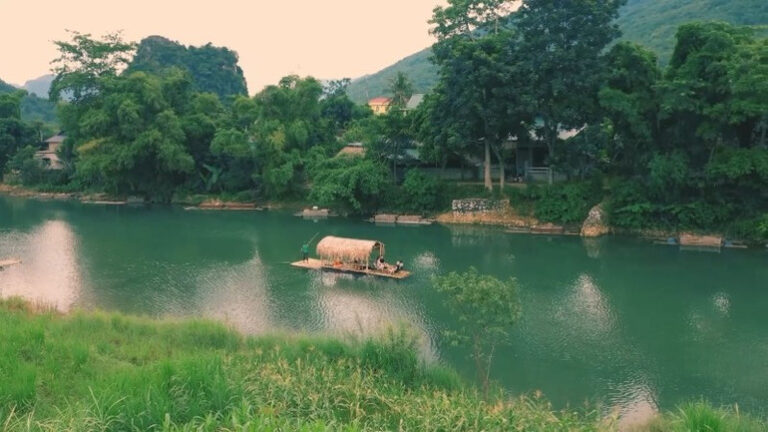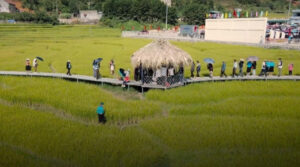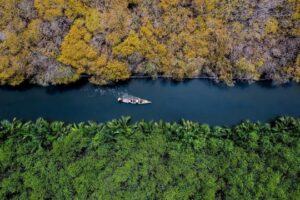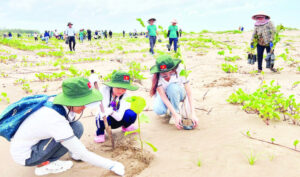The grandiose and mysterious caves of Phong Nha-Ke Bang National Park have become a tourist trap for Quang Binh Province, attracting over four million visitors in the past decade. Hoang Trung Hieu reports.
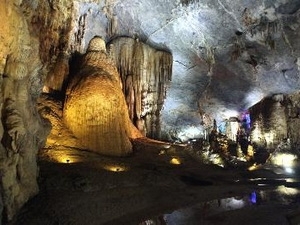
In the words of Phan Van Thang, 24, a guide for Ha Noi Redtours, central Quang Binh's world-renowned caves are "imposing and beautiful".
The area, recognised as a UNESCO World Heritage Site, features breathtaking natural treasures, including the world's largest cave, Son Doong.
But despite dozens of visits, it's the Thien Duong (Paradise) Cave that still leaves him with the deepest impression – bewitching with its blend of majesty and mystery.
Early in the morning, while the grass was still wet with dew, Thang led us on an exploration of his favourite cave.
Leaving Dong Hoi City centre, our car headed west, begining a spectacular 60km trip.
On both sides of the road, mother nature blessed the province with a luscious green landscape boasting vast rubber tree forests and limestone mountains, punctuated by the sound of cows chomping on grass.
Our journey to the cave led us through Phong Nha-Ke Bang National Park and the legendary Son River. Historical myths claim that a young couple chose to drown themselves in the river as they could not bear to be forced apart, prompting locals to call it Son (Red) to commemorate their faithfulness.
Then suddenly, the mountain appeared. But to reach Paradise, we had to climb 524 stairs, with many liana resembling giant snakes along the way. The cave is hidden by a primitive jungle that shrouds visitors from sunlight as they make their way to the entrance.
Into the depths
The opening of the cave is quite modest and I was surprised to learn that it is made up of two fossilised tree trunks.
Perhaps nobody could imagine that behind this small and simple gate, there lies a grandiose cave, housing gigantic hollows and a marvellous structure.
We headed down wooden steps to begin our voyage around this world hidden inside a mountain.
Having squeezed through the entrance, we were met by a huge cavern which had a grandeur reminiscent of Saint Peter's Chancel in the Vatican. We were overcome with astonishment at the cave's sheer magnificence.
"I feel like a new sky has been opened to us," said Quynh Huong, a visitor from Ha Noi.
The ceiling looked like a gothic arch, a bastion of Western culture, but on the floor there were eyecatching images paying tribute to Oriental culture.
"Some stalagmites remind us of Buddha, the Great Wall of China, and a rong (communal house) of Tay Nguyen (the Central Highlands)," she said.
The cave's ceiling is about 80-100m high and concords with its floor, giving the impression of a grand stone palace, with numerous stalactites twinkling in the gloom.
Each part of the cave opened up to reveal a different space, with giant shapes of unicorns, lions and dragons, while we passed over the desert-like floor featuring wave-shaped sandstone.
Many stopped to examine a stalagmite that resembled Buddha Kwan Yin statue, while on the other side of the path stood an image of Mary holding an infant Jesus.
Viet Nam's rich and diverse history has led to many manifestations of reconciliation between different religions, but perhaps this is the first time it has occurred in such a natural space, with many different religious symbols located just metres apart.
Discovered by local man Ho Khanh in 2005, members of the British Cave Research Association (BCRA) then explored it and came up with the name "Paradise".
They concluded the cave was formed about 300-400 million years ago and announced it as "the longest dry cave in Asia". It stands 100m high, more than 200m wide, and is large enough to fit 1,000 people.
Explorers say Paradise Cave is much more beautiful and mystical than nearby Phong Nha Cave, which is a UNESCO World Heritage Site.
Paradise is 31.4km long, but only the first kilometre has been opened to tourists by Truong Thinh Corp, which stumped up an initial investment of VND83 billion (US$4.3 million) to make the cave accessible, fitting a wooden walkway for guests to follow inside the cave.
"The next 6km is for people who want to try a more adventurous tour," says Thang.
World Natural Heritage
The Phong Nha-Ke Bang National Park was recognised by UNESCO as World Natural Heritage in 2003. It covers 85,754ha, including primitive forests, tropical jungles, rivers, grassland and especially giant caves.
Dang Dong Ha, deputy director of the National Park, says the 22 explorations since 1990 by the world-famous cave experts, particularly the BCRA's experts led by Howard Limbert, have thrown up surprise after surprise.
"The Phong Nha-Ke Bang has become a ‘kingdom of caves' not only for Viet Nam but also for Asia and the wider world. According to explorers, the region has thousands caves, and they have so far explored more than 170, with a total length of several hundred kilometres."
Ha said the discovery of Phong Nha, Paradise, Khe Ry, Gio (Wind), Va, Tu Lan caves and especially Son Doong Cave have shook the cave world to its very foundations.
"BCRA lists Quang Binh as having the most beautiful caves in Asia and the biggest cave in the world. Phong Nha has the longest underground river (stretching 7.7km), Paradise is the longest dry cave in Asia and has the largest gigantic stalactites, while Son Doong is considered the biggest cave in the world," added Ha.
Ha says thanks to these natural treasures, the provincial tourism industry has made great strides, with four million people visiting the National Park since 2003 to date.
In 2009, Ho Khanh discovered another giant cave that he named Son Dooøng. This cave, with a primitive forest inside, is now a destination for scientific explorers.
"Phong Nha-Ke Bang has many caves as unique as Son Doong but still undiscovered, because the explorers have yet to cover every area. In the 1990s, I visited many caves even more beautiful and stranger than Son Doong, but to find them again today, we need time and equipment," he said.
Experts Howard Limbert and Debbie Limbert say that in Quang Binh's Son Trach region, many rivers' sources have not been found, so there must be many caves yet to be discovered. Perhaps a cave larger than Son Doong is still hidden somewhere in the limestone mountains of the Truong Son range, said Howard Limbert.
To celebrate the 10th anniversary of Phong Nha-Ke Bang National Park's recognition by UNESCO as World Natural Heritage, Quang Binh Province will organise a ceremony on May 25.
The Park's deputy chief, Hoang Hai Van, says the event will be held at Paradise Cave.
"This will be an opportunity to showcase the systems of Phong Nha-Ke Bang's many grandiose caves, considered the world's finest," he said.
Van added that during the event, the province will announce a large investment in the Park from a South Korean group.
"We will exploit the special gifts that Mother Nature bestowed on Phong Nha-Ke Bang, but protecting its ecological environment is also an important task, so we must proceed with caution.


